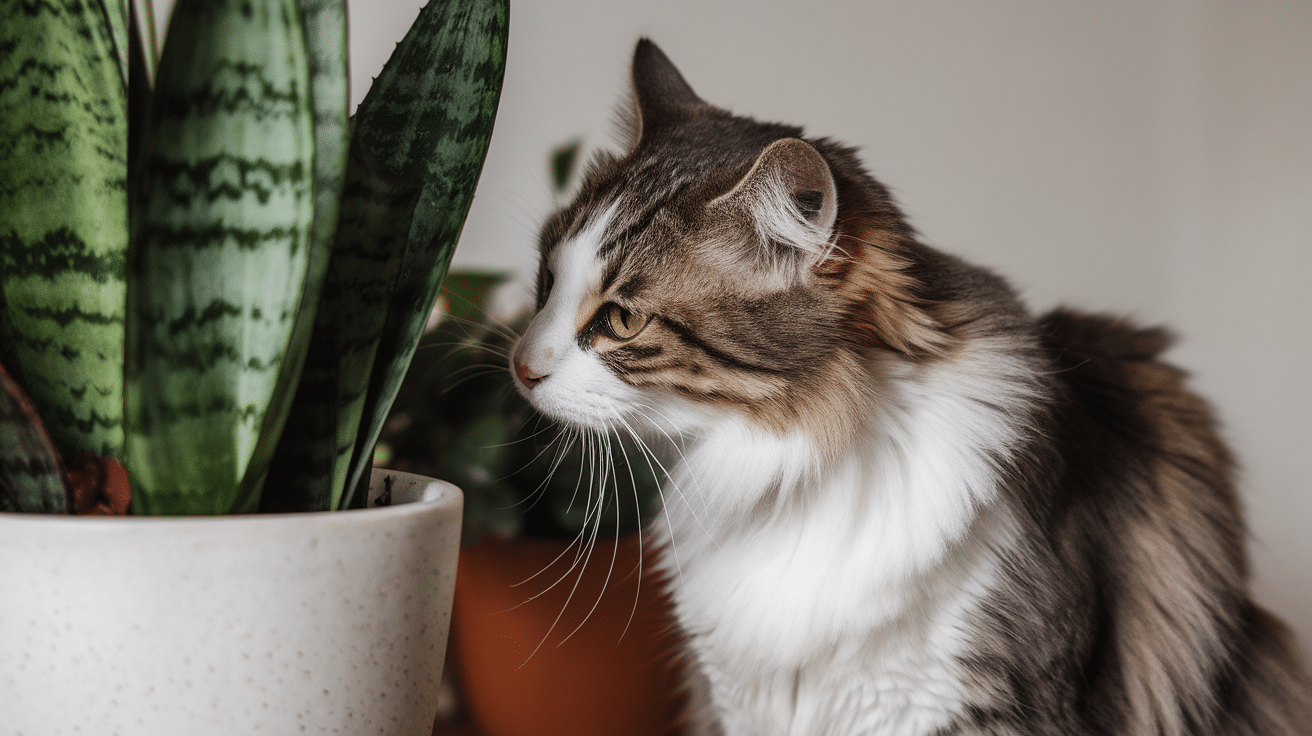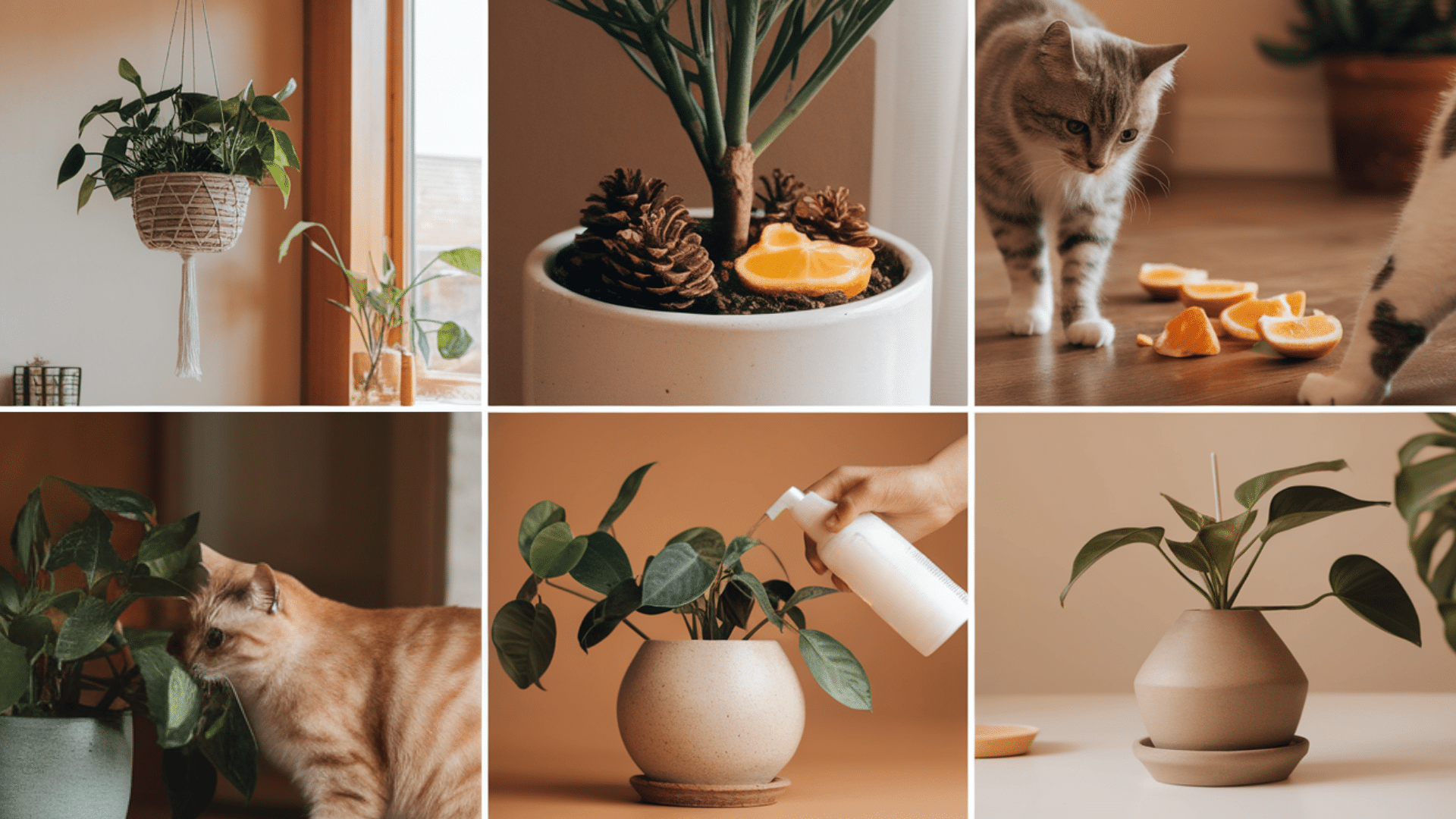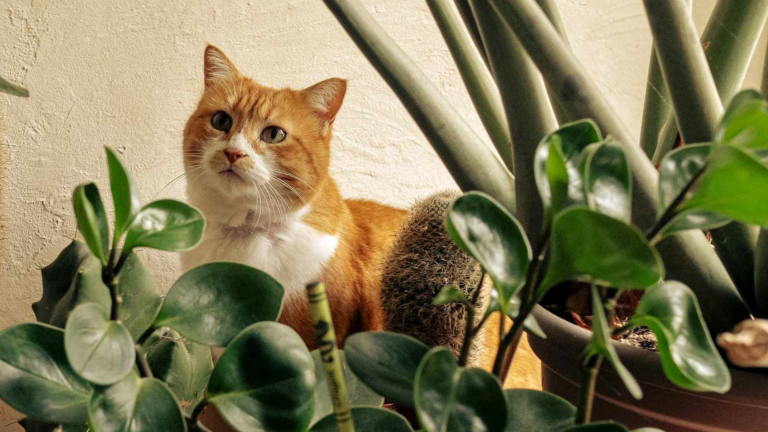Do your cats love getting into your plants? You’re not alone! Many cat owners struggle to keep their curious pets away from houseplants and gardens. Cats love to dig in the dirt, chew on leaves, or even use plant pots as litter boxes.
While it can be frustrating, there are simple and safe ways to protect your plants without hurting your furry friend. In this blog, I’ll share easy tips that really work, no matter if your plants are indoors or outside.
From using smells cats don’t like to adding harmless barriers, this blog has got you covered. You’ll also learn how to keep your cat happy with fun distractions so they leave your plants alone.
With just a few changes, your plants can stay healthy, and your cat can stay out of trouble. Let’s look at how to keep cats away from plants the easy way!
What Makes Plants So Tempting to Cats?

If you’ve ever caught your cat chewing on a plant, you might wonder: Is this safe? The truth is, some plants can be harmful to cats, while others are totally fine.
Plants like lilies, aloe vera, and pothos are toxic and can make your cat sick if they eat them. That’s why it’s important to know which plants are safe and which ones to keep out of reach.
So, why do cats love plants so much? Cats are curious by nature. They like the smell, the movement of leaves, and the texture of the soil. Some cats chew on plants out of boredom, while others dig in the dirt like it’s a fun game.
Understanding this behavior can help you stop it. With safe plants and a few clever tricks, you can protect both your plants and your cat.
What Plants Are Harmful to Cats?
Not all plants are safe for your cat. Some can make them really sick if they chew on the leaves or flowers. Even a small bite can cause problems like an upset stomach, drooling, or worse. That’s why it’s important to know which plants to keep out of your home or garden. Some common plants include:
- Lilies: Even just licking the pollen can cause serious kidney problems.
- Aloe Vera: Great for humans, but bad for cats. It can cause vomiting and diarrhea.
- Pothos (Devil’s Ivy): A popular houseplant, but dangerous if chewed.
- Peace Lily: It’s not a true lily, but still toxic to cats.
- Sago Palm: Very poisonous. Just a small piece can cause liver failure.
- Tulips: The bulbs are the most toxic part.
- Philodendron: Can cause mouth pain, drooling, and stomach issues.
- Dieffenbachia (Dumb Cane): Can cause swelling in the mouth and trouble breathing.
If you’re not sure if a plant is safe, look it up or ask your vet. Keeping harmful plants out of reach can protect your cat and give you peace of mind.
Tricks to Keep Cats from Messing with Indoor Plants

Keeping your indoor plants safe from curious cats can be tricky, but it’s totally doable with a few smart tricks. Cats love to dig in the dirt, chew on leaves, or even knock over plant pots. Here are some easy ways to protect your plants and keep your cat happy, too.
1. Move Plants Out of Reach
One of the best ways to keep cats away is to place plants where they can’t get to them. Use hanging planters, high shelves, or wall-mounted holders. Just make sure they’re sturdy so your cat doesn’t knock them down. A wobbly shelf can be dangerous for both your plant and your cat, so always double-check before placing anything high up.
2. Block Access
Try placing decorative stones, pinecones, or mesh on top of the soil. This makes digging less fun for your cat. You can also use plant cages or terrariums to cover the plant fully. It keeps curious paws out and still lets your plant get all the light and air it needs.
3. Use Smells Cats Don’t Like
Cats don’t like strong smells like citrus or vinegar. Try putting orange or lemon peels in the soil, or gently spray the leaves with a mix of water and lemon juice. Just be careful not to harm the plant. Start with a small amount first to see how your plant reacts, and add more if it works.
4. Try Bitter Sprays
There are pet-safe sprays made to taste bad to cats. You can spray them on the leaves (just make sure they’re safe for your type of plant). One taste, and most cats will stop trying to chew again. These sprays are easy to find online or at pet stores and don’t leave a strong smell behind.
5. Use Double-Sided Tape
Cats don’t like the sticky feel on their paws. Try placing double-sided tape around the base of your plant pots or on the table they sit on. It’s not harmful, but it’s annoying enough to keep them away. After a few tries, most cats will avoid the area altogether.
6. Choose Heavier Pots
If your cat likes to knock things over, switch to heavier pots or planters. This makes it harder for your cat to tip them and helps avoid messes or broken pots. You can also try pots with wide bases, which are harder to flip or move around. Adding a non-slip mat underneath can give extra grip and keep the pot in place.
7. Rotate and Rearrange
Sometimes, just changing where your plants sit is enough to throw your cat off. Try moving plants to new spots now and then so your cat doesn’t get too comfortable around them. Switching things up can also help protect the plants while keeping your cat curious and distracted, harmlessly.
With these simple steps, you can enjoy healthy indoor plants and a happy cat—all in the same space.
Keeping Cats Away From an Outdoor Garden

If your cat—or the neighborhood cats—are turning your garden into their personal playground or litter box, don’t worry. There are safe, simple ways to protect your outdoor plants without hurting the cats or the garden.
1. Use Cat-Repellent Plants
Some plants naturally keep cats away because of their strong smell. Try planting lavender, rosemary, or Coleus Canina (also known as the “Scaredy Cat” plant) around your garden. These plants look nice and help keep cats at a distance. Plus, they’re easy to grow and can also attract helpful pollinators like bees and butterflies.
2. Cover the Soil
Cats love soft dirt for digging. Add a layer of pinecones, gravel, or bark mulch on top of the soil. You can also place chicken wire or garden mesh just under the surface. It’s safe for plants but uncomfortable for paws. This makes the area much less fun for digging or using as a litter box.
3. Add Motion-Activated Sprinklers
Cats hate surprise water sprays. A motion-activated sprinkler will spray a quick burst of water when it senses movement. It won’t hurt the cat, but it’ll make them think twice before coming back. It also helps keep other animals, like raccoons or squirrels, out of your garden.
4. Try Strong Smells
Like indoors, certain smells can keep cats away. Sprinkle citrus peels, coffee grounds, or vinegar-soaked cotton balls around your plants. Just make sure they don’t harm your plants or soil. You may need to reapply these items after rain to keep them working.
5. Use Garden Fencing or Netting
You can use low fencing or netting around your flower beds or vegetable garden. It’s a simple way to block entry without making your garden look messy. Try using green or black mesh, so it blends in better with your plants. You can also shape the fencing into small arches to protect delicate areas without blocking sunlight.
With a little creativity and care, you can protect your outdoor garden while keeping it safe and friendly for cats and other animals.
Teaching Your Cat to Leave Plants Alone
Sometimes, the best way to keep cats away from plants is to teach them what’s okay and what’s not. It may take a little time and patience, but with positive training, your cat can learn to stay out of the plant pots and garden beds.
1. Use a Firm “No”: If you catch your cat messing with your plants, gently say “No” in a firm voice. Then move them away from the plant. Do this every time. Cats are smart—they’ll start to understand that plants are off-limits.
2. Reward Good Behavior: When your cat walks past a plant without touching it, give them a treat, pet them, or say something nice like “Good kitty!” Cats respond well to praise and rewards, just like dogs.
3. Offer Better Options: Sometimes, cats mess with plants because they’re bored. Try giving your cat new toys, a scratching post, or a cozy spot near a window. You can also grow cat grass or catnip just for them.
4. Use Sounds to Set Boundaries: If your cat jumps into a plant or garden bed, try clapping your hands or using a small bell to make a sound. This is not to scare them—it’s just a way to break their focus and stop the behavior.
5. Be Patient and Consistent: Training takes time. The key is to stay calm and be consistent. Don’t yell or punish your cat. Instead, guide them with love and gentle correction. Over time, they’ll learn what’s okay and what’s not.
With some patience and positive training, you can help your cat understand the rules—and protect your plants without stress!
Important Safety Tips for You and Your Cat
When trying to keep cats away from your plants, it’s super important to make sure that everything you use is safe for both your cat and your plants.
1. Avoid Harmful Sprays and Chemicals: Never use harsh cleaners, bug sprays, or plant treatments that contain toxic ingredients. Cats often lick their paws or chew leaves, so even small amounts can be dangerous.
2. Use Natural Deterrents Carefully: Some natural items like citrus peels or vinegar work well to keep cats away, but don’t use too much. If overdone, they can harm sensitive plants or irritate your cat’s nose.
3. Check Plants for Toxicity: Make sure every plant in your home or garden is safe for cats. Even popular ones like lilies and aloe vera can be toxic. Do a quick search or ask your vet if you’re unsure.
4. Avoid Sharp or Harmful Barriers: Things like chicken wire, pinecones, or rocks can help protect your garden, but make sure nothing has sharp edges that could hurt curious paws.
5. Watch for Stress in Your Cat: If your cat seems scared, anxious, or starts acting out, they may not like a new sound, smell, or setup. Try something else that works better for them. Always keep your cat’s comfort in mind.
Keeping your plants safe shouldn’t come at the cost of your cat’s health or happiness. With the right tools and a little care, you can find a balance that works for both!
Conclusion
Keeping cats away from your plants might seem tricky at first, but it’s totally possible with a few simple steps. If you’re dealing with indoor plants or outdoor gardens, there are safe and easy ways to protect them.
From using smells cats don’t like to adding physical barriers, you can find what works best for your home. Don’t forget—your cat isn’t being bad on purpose. They’re just curious, playful, or maybe even a little bored. Give them something fun like cat grass or toys, and they’ll be less likely to bother your plants.
And if you train them with gentle words and rewards, they’ll learn the rules in no time. Just remember always to keep your cat’s safety in mind and avoid anything harmful.
With a little patience and care, you can enjoy your plants and your furry friend without the mess or stress!













